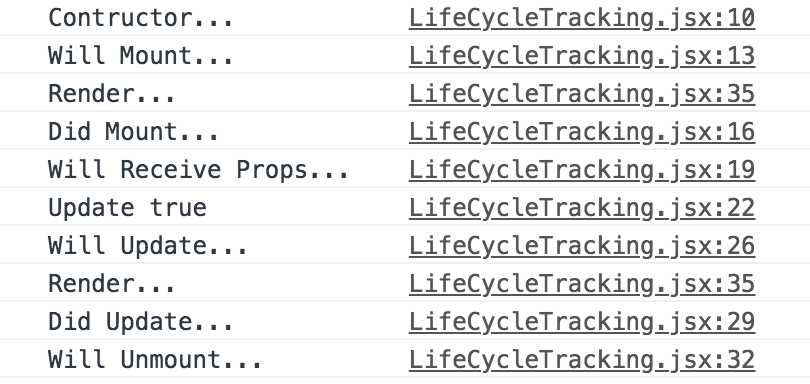标签:初始 src extend 好的 前言 end image def 方法
参考了很多文章,结合实例写下我自己的理解
react中component生命周期主要分为三个阶段:加载、更新和卸载
1、加载(Mounting) 主要包含4个方法
constructor(),componentWillMount(),render()和componentDidMount()
2、更新(Updating) 主要包含5个方法
componentWillReceiveProps(),shouldComponentUpdate(),componentWillUpdate(),render()和componentDidUpdate()
3、卸载(Unmounting) 主要包含1个方法
componentWillUnmount()
import React from ‘react‘; class LifeCycleTracking extends React.Component { constructor(props) { super(props); this.state = { content: ‘This is lifecycle tracking content‘ } console.log("Contructor..."); } componentWillMount() { console.log("Will Mount..."); } componentDidMount() { console.log("Did Mount..."); } componentWillReceiveProps() { console.log("Will Receive Props..."); } shouldComponentUpdate() { console.log("Update true"); return true; } componentWillUpdate() { console.log("Will Update..."); } componentDidUpdate() { console.log("Did Update..."); } componentWillUnmount() { console.log("Will Unmount..."); } render() { console.log("Render..."); return ( <div> <h2>{this.props.title}</h2> <p>{this.state.content}</p> </div> ); } } export default LifeCycleTracking;
进入页面时


当change state时

可以看到,当进入页面时,会先执行constructor()函数
constructor(props):该方法在组件加载前调用。当组件作为React.Component的子类实现时需要在其他声明之前先调用super(props)。否则,this.props在构造器中会是undefined,这会导致代码出现bug。
作用:用来初始化状态,如果既不初始化状态也不绑定方法,那就没必要实现该方法了。(注:事实上,如果组件没有构造器方法的话,组件会默认调用一个构造器,实现属性的传递)。
只要组件存在constructor,就必要要写super,否则this指向会错误
执行完constructor()函数之后,会依次执行componentWillMount(),render()和componentDidMount()函数
componentWillMount():组件刚经历constructor(),初始完数据,组件还未进入render,组件还未渲染完成,dom还未渲染,一般不用。
render():该方法必须要有,主要提供渲染页面的数据,调用该方法时,会检查其中的props和state,以此来渲染页面。
componentDidMount():说明第一次渲染已完成,此时dom节点已经生成,可以在这里调用ajax请求,返回数据setState后组件会重新渲染,也可以在此处设置定时器等。
注:在此处设置状态等会导致页面重新渲染
到此为止,页面的第一次渲染结束,此时,如果更新了state,页面会进行第二次渲染,会依次执行componentWillReceiveProps(),shouldComponentUpdate(),componentWillUpdate(),render()和componentDidUpdate()函数。
componentWillReceiveProps():该方法会在加载好的组件在收到新的状态后调用。它接受一个参数nextProps,通过对比nextProps和this.props,将nextProps setState为当前组件的state,从而重新渲染组件。
shouldComponentUpdate():简单理解为这个component需不需要更新,在react中,父组件更新之后,所有的子组件都会相应更新,但这时我们不需要子组件更新,可以在此方法中return false,即可阻止更新。
componentWillUpdate():shouldComponentUpdate返回true以后,组件进入重新渲染的流程,进入componentWillUpdate,这里同样可以拿到nextProps和nextState。
componentDidUpdate():可用来在组件更新后操作DOM,这里可以拿到更新前的props和state,通过比较当前属性和之前属性来决定是否发送网络请求(如,状态未改变不需要做网络请求)。
当点击unMount时,会执行componentWillUnmount()方法。
componentWillUnmount():该方法会在组件被销毁前立即调用。
作用:可以在方法内实现一些清理工作,如清除定时器,取消网络请求或者是清理其他在componentDidMount()方法内创建的DOM元素。
这就是react component生命周期的简单学习经验啦,任重而道远,努力终会成功。
标签:初始 src extend 好的 前言 end image def 方法
原文地址:https://www.cnblogs.com/kennethDu/p/9367167.html